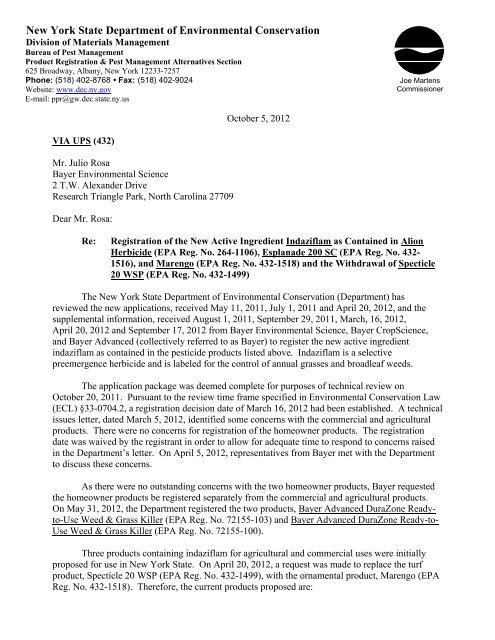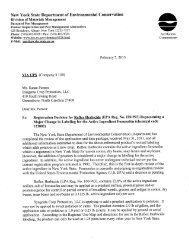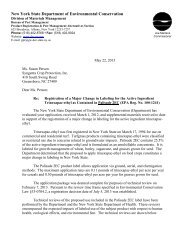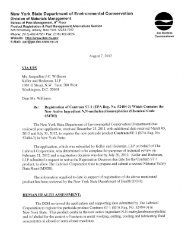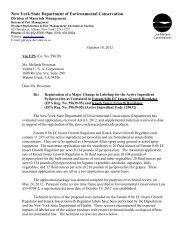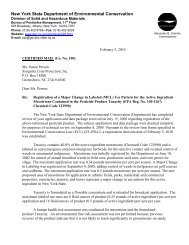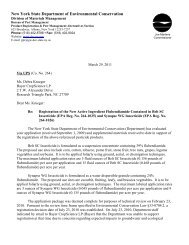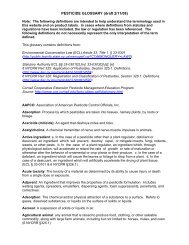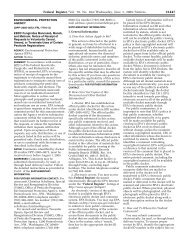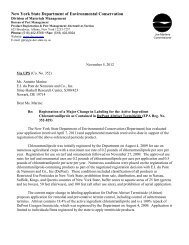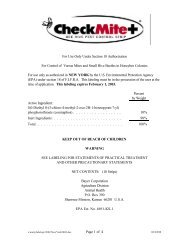New York State Department of Environmental Conservation
New York State Department of Environmental Conservation
New York State Department of Environmental Conservation
Create successful ePaper yourself
Turn your PDF publications into a flip-book with our unique Google optimized e-Paper software.
<strong>New</strong> <strong>York</strong> <strong>State</strong> <strong>Department</strong> <strong>of</strong> <strong>Environmental</strong> <strong>Conservation</strong><br />
Division <strong>of</strong> Materials Management<br />
Bureau <strong>of</strong> Pest Management<br />
Product Registration & Pest Management Alternatives Section<br />
625 Broadway, Albany, <strong>New</strong> <strong>York</strong> 12233-7257<br />
Phone: (518) 402-8768 • Fax: (518) 402-9024<br />
Website: www.dec.ny.gov<br />
E-mail: ppr@gw.dec.state.ny.us<br />
VIA UPS (432)<br />
Mr. Julio Rosa<br />
Bayer <strong>Environmental</strong> Science<br />
2 T.W. Alexander Drive<br />
Research Triangle Park, North Carolina 27709<br />
Dear Mr. Rosa:<br />
October 5, 2012<br />
Joe Martens<br />
Commissioner<br />
Re: Registration <strong>of</strong> the <strong>New</strong> Active Ingredient Indaziflam as Contained in Alion<br />
Herbicide (EPA Reg. No. 264-1106), Esplanade 200 SC (EPA Reg. No. 432-<br />
1516), and Marengo (EPA Reg. No. 432-1518) and the Withdrawal <strong>of</strong> Specticle<br />
20 WSP (EPA Reg. No. 432-1499)<br />
The <strong>New</strong> <strong>York</strong> <strong>State</strong> <strong>Department</strong> <strong>of</strong> <strong>Environmental</strong> <strong>Conservation</strong> (<strong>Department</strong>) has<br />
reviewed the new applications, received May 11, 2011, July 1, 2011 and April 20, 2012, and the<br />
supplemental information, received August 1, 2011, September 29, 2011, March, 16, 2012,<br />
April 20, 2012 and September 17, 2012 from Bayer <strong>Environmental</strong> Science, Bayer CropScience,<br />
and Bayer Advanced (collectively referred to as Bayer) to register the new active ingredient<br />
indaziflam as contained in the pesticide products listed above. Indaziflam is a selective<br />
preemergence herbicide and is labeled for the control <strong>of</strong> annual grasses and broadleaf weeds.<br />
The application package was deemed complete for purposes <strong>of</strong> technical review on<br />
October 20, 2011. Pursuant to the review time frame specified in <strong>Environmental</strong> <strong>Conservation</strong> Law<br />
(ECL) §33-0704.2, a registration decision date <strong>of</strong> March 16, 2012 had been established. A technical<br />
issues letter, dated March 5, 2012, identified some concerns with the commercial and agricultural<br />
products. There were no concerns for registration <strong>of</strong> the homeowner products. The registration<br />
date was waived by the registrant in order to allow for adequate time to respond to concerns raised<br />
in the <strong>Department</strong>’s letter. On April 5, 2012, representatives from Bayer met with the <strong>Department</strong><br />
to discuss these concerns.<br />
As there were no outstanding concerns with the two homeowner products, Bayer requested<br />
the homeowner products be registered separately from the commercial and agricultural products.<br />
On May 31, 2012, the <strong>Department</strong> registered the two products, Bayer Advanced DuraZone Readyto-Use<br />
Weed & Grass Killer (EPA Reg. No. 72155-103) and Bayer Advanced DuraZone Ready-to-<br />
Use Weed & Grass Killer (EPA Reg. No. 72155-100).<br />
Three products containing indaziflam for agricultural and commercial uses were initially<br />
proposed for use in <strong>New</strong> <strong>York</strong> <strong>State</strong>. On April 20, 2012, a request was made to replace the turf<br />
product, Specticle 20 WSP (EPA Reg. No. 432-1499), with the ornamental product, Marengo (EPA<br />
Reg. No. 432-1518). Therefore, the current products proposed are:
Mr. Julio Rosa 2.<br />
1. Alion Herbicide (EPA Reg. No. 264-1106) contains 19.05% indaziflam for pre-emergent<br />
weed control in citrus fruit, stone fruit, pome fruit, tree nuts and pistachios and non-crop<br />
areas on farmsteads. The highest single application rate for agricultural areas is 0.085 lbs<br />
AI/acre and the maximum seasonal application rate is 0.134 lbs AI/acre. Two applications<br />
can be made per year with a 30 day interval between applications, as long as the maximum<br />
seasonal rate is not exceeded. For farmsteads, the highest application rate is 0.085 lb<br />
AI/acre and the maximum seasonal application rate is 0.089 lb AI/acre.<br />
2. Esplanade 200 SC (EPA Reg. No. 432-1516) contains 19.05% indaziflam for pre-emergent<br />
control <strong>of</strong> annual grasses and broadleaf weeds in non-residential non-crop areas, railroad and<br />
rail yards, managed roadsides, fence rows, utilities, hardscapes, industrial, municipal, and<br />
government sites. The highest single application rate is 0.09 lbs AI/acre and the maximum<br />
seasonal application rate is 0.13 lbs AI/acre. Two applications can be made per year as long<br />
as the maximum seasonal rate is not exceeded, however the label does not specify an<br />
interval between applications.<br />
3. Marengo (EPA Reg. No. 432-1518) was submitted as a replacement product after the<br />
technical reviews were completed and thus not mentioned in those reviews. This product<br />
contains 7.4% indaziflam and is for pre-emergent control in ornamentals in outdoor<br />
nurseries, shadehouses, hoop houses, Christmas trees, and conifer plantations and in<br />
ornamental production sites in areas covered with landscaped fabric. For ornamentals,<br />
conifers and Christmas trees, the highest single application rate is 0.075 lbs AI/acre and the<br />
maximum seasonal application rate is 0.09 lbs AI/acre. Two applications can be made per<br />
year with a three month interval between applications, as long as the maximum seasonal rate<br />
is not exceeded. For ornamental production facilities, a one time application <strong>of</strong> 0.09 lb<br />
AI/acre can be applied prior to plant production.<br />
Specticle 20 WSP (EPA Reg. No. 432-1499) was initially submitted for registration, but<br />
was replaced with Marengo after the technical reviews were completed. This product contained<br />
20% indaziflam and was for pre-emergent control <strong>of</strong> annual grasses, annual sedges, and broadleaf<br />
weeds in turfgrass, landscape ornamentals, Christmas trees, and hardscapes. The highest single<br />
application rate was 0.062 lbs AI/acre and the maximum seasonal application rate was 0.089 lbs<br />
AI/acre.<br />
The <strong>Department</strong> hereby accepts the registration <strong>of</strong> the new active ingredient,<br />
indaziflam, as contained in the three products listed above. The products are registered as<br />
“restricted” use with labeled restrictions concerning applications in Nassau and Suffolk counties,<br />
<strong>New</strong> <strong>York</strong>. The <strong>Department</strong> and the <strong>New</strong> <strong>York</strong> <strong>State</strong> <strong>Department</strong> <strong>of</strong> Health evaluated the<br />
application and all supporting documents submitted to date regarding human health and the<br />
environment in <strong>New</strong> <strong>York</strong> <strong>State</strong>. The following are the technical reviews for the active ingredient.<br />
HUMAN HEALTH RISK ASSESSMENT<br />
The <strong>New</strong> <strong>York</strong> <strong>State</strong> <strong>Department</strong> <strong>of</strong> Health (NYSDOH) reviewed the data, submitted by<br />
Bayer in support <strong>of</strong> the registration <strong>of</strong> the new active ingredient, indaziflam. The NYSDOH stated<br />
that neither indaziflam nor any <strong>of</strong> the formulated products was very toxic in acute oral, dermal or<br />
inhalation exposure studies in laboratory animals. In addition, neither the active ingredient nor the<br />
formulated products were very irritating to skin and eyes (tested on rabbits) or skin sensitizers<br />
(tested on guinea pigs).
Mr. Julio Rosa 3.<br />
Indaziflam caused some toxicity in mice, rats and dogs in chronic feeding studies. In a<br />
chronic feeding/oncogenicity study in mice, decreased body weight, body weight gain and food<br />
consumption in both sexes, renal and liver toxicity in males, and stomach and ovary toxicity in<br />
females were reported at 142 milligrams indaziflam per kilogram body weight per day (mg/kg/day)<br />
in males and 168 mg/kg/day in females; the respective no-observed-effect-levels (NOELs) were<br />
34 mg/kg/day and 42 mg/kg/day. In a chronic feeding/oncogenicity study in rats, indaziflam caused<br />
decreased body weight/weight gain, signs <strong>of</strong> neurotoxicity (various symptoms, including dilated<br />
pupils, tremors, limb/movement effects, reduced activity/alertness) and renal toxicity in females,<br />
atrophic seminal vesicles, increased TSH (Week 3 only) and thyroid colloid alteration in males, as<br />
well as liver toxicity in both sexes at 118 mg/kg/day in males and 167 mg/kg/day in females; the<br />
NOELs were 12 mg/kg/day and 17 mg/kg/day in males and females, respectively. In a one-year<br />
dog feeding study, indaziflam caused axonal degeneration <strong>of</strong> nerve fibers in the brain, spinal cord<br />
and sciatic nerve at 6 mg/kg/day in males and 7 mg/kg/day in females; the NOEL was 2 mg/kg/day<br />
in both sexes. The United <strong>State</strong>s <strong>Environmental</strong> Protection Agency (U.S. EPA) Office <strong>of</strong> Pesticide<br />
Programs (OPP) established a chronic reference dose (cRfD) for indaziflam <strong>of</strong> 0.02 mg/kg/day<br />
based on the NOEL from this study and an uncertainty factor <strong>of</strong> 100. This RfD has not yet been<br />
adopted by the U.S. EPA’s Integrated Risk Information System (IRIS).<br />
Indaziflam also caused some developmental toxicity in the <strong>of</strong>fspring <strong>of</strong> pregnant rats, but<br />
not rabbits, exposed to this chemical during organogenesis at doses that also caused maternal<br />
toxicity. In the rat, developmental effects were characterized by decreased fetal body weights at<br />
200 mg/kg/day; the NOEL was 25 mg/kg/day. Maternal effects were observed at 200 mg/kg/day<br />
and included decreased body weight gain and food consumption; the NOEL was 25 mg/kg/day. In<br />
the rabbit, indaziflam did not cause any developmental toxicity up to 60 mg/kg/day, the highest<br />
dose tested. Maternal toxicity was characterized by decreased body weight gain and food<br />
consumption and macroscopic changes in the liver in one doe at 60 mg/kg/day; the NOEL was<br />
25 mg/kg/day. In a multi-generation reproduction study in rats, indaziflam was associated with<br />
decreased pup body weights throughout the postnatal period and clinical signs <strong>of</strong> toxicity (perianal,<br />
urine or nasal staining, diarrhea or s<strong>of</strong>t stool, distended abdomen, weakness, tremors, myoclonus,<br />
increased activity and reactivity) at 317.6 mg/kg/day in males and 355.2 mg/kg/day in females; the<br />
respective NOELs were 69.3 mg/kg/day and 85.2 mg/kg/day. Reproductive toxicity was reported<br />
as delayed sexual maturation at 317.6 mg/kg/day in males and 355.2 mg/kg/day in females; the<br />
respective NOELs were 69.3 mg/kg/day and 85.2 mg/kg/day. Parental toxicity consisted <strong>of</strong> coarse<br />
tremors in females, renal toxicity (tubular degeneration/regeneration and increased weight) in males<br />
and decreased body weight, body weight gain and food consumption in both sexes at 560.1<br />
mg/kg/day in males and 656.2 mg/kg/day in females. The NOELs for parental toxicity were 69.3<br />
mg/kg/day and 85.2 mg/kg/day in males and females, respectively.<br />
Indaziflam caused some effects in acute, subchronic and developmental neurotoxicity<br />
studies in rats. In the acute study, decreased motor and locomotor activity in females was observed<br />
at 100 mg/kg; the NOEL was 50 mg/kg. In the subchronic study, indaziflam caused decreased body<br />
weights and total session motor/locomotor activity in females and decreased overall cumulative<br />
body weight gain and clinical signs <strong>of</strong> toxicity (tremors, repetitive chewing motion and perianal and<br />
lacrimal staining) in both sexes at 585.7 mg/kg/day in males and 580.9 mg/kg/day in females; the<br />
respective NOELs were 243.6 mg/kg/day and 306.9 mg/kg/day. Indaziflam additionally caused<br />
decreased body weights in both sexes and decreased motor activity in male pups on post-natal-day<br />
21 at 432 mg/kg/day; the NOEL was 83.8 mg/kg/day. Maternal toxicity was characterized by<br />
clinical signs at daily observation (coarse tremors, dilated pupils and dilated pupils unresponsive to<br />
penlight, nasal staining, and repetitive chewing movements) at 432 mg/kg/day; the NOEL was 83.8
Mr. Julio Rosa 4.<br />
mg/kg/day. The U.S. EPA OPP established an acute reference dose (aRfD) for indaziflam <strong>of</strong><br />
0.5 mg/kg/day based on the NOEL <strong>of</strong> 50 mg/kg/day from the acute neurotoxicity study in rats and<br />
an uncertainty factor <strong>of</strong> 100 to account for interspecies extrapolation and human variability.<br />
Indaziflam did not cause oncogenic effects in rat or mouse chronic feeding studies. This<br />
compound was also negative in a number <strong>of</strong> genotoxicity studies. The U.S. EPA classified<br />
indaziflam as “not likely to be carcinogenic to humans.”<br />
The U.S. EPA established tolerances for indaziflam residues in or on a number <strong>of</strong> crops and<br />
animal commodities (Federal Register 76 (No. 66): 18,899−18,906; April 6, 2011). The acute<br />
population adjusted dose for this active ingredient (aPAD) is 0.5 mg/kg/day and has the same basis<br />
as the aRfD. The U.S. EPA estimated the acute dietary exposure to indaziflam from food and<br />
drinking water would be three percent <strong>of</strong> the aPAD for all infants (< 1 year old), the highest<br />
exposed subgroup, and less than one percent for the general population and all other population<br />
subgroups. The chronic population adjusted dose (cPAD) for indaziflam is 0.02 mg/kg/day and has<br />
the same basis as the cRfD. The U.S. EPA estimated that the chronic dietary exposure from all<br />
crops for which there are tolerances and drinking water to indaziflam residues would be three<br />
percent <strong>of</strong> the cPAD for the general population, ten percent for all infants less than one-year-old and<br />
five percent for children one-to-two years old. These exposure analyses are based on the<br />
assumption that 100 percent <strong>of</strong> crops are treated and contain tolerance level residues. Actual<br />
residues and resulting exposure levels are expected to be less than these assessments estimate.<br />
The U.S. EPA reported the extensive results <strong>of</strong> several occupational and residential risk<br />
assessments for exposures to indaziflam from a variety <strong>of</strong> crop and non-crop uses. Occupational<br />
and residential risks were estimated for short- (1−30 days)/intermediate-term (1−6 months)<br />
combined dermal and inhalation exposures and for short-term dermal post-application exposures.<br />
Post-application inhalation risks were not assessed because indaziflam is applied at low application<br />
rates (maximum 57 grams per acre) and has a rather low vapor pressure (1.9 x 10 -10 mm Hg). For<br />
determining margins <strong>of</strong> exposure (MOEs) for all application and post-application scenarios, the<br />
U.S. EPA compared estimated combined dermal and inhalation exposures to a NOEL <strong>of</strong> 7.5<br />
mg/kg/day from a subchronic feeding study in the dog (axonal degenerative microscopic findings in<br />
the brain, spinal cord and sciatic nerve). The U.S. EPA considered MOEs <strong>of</strong> 100-fold or greater to<br />
provide adequate worker and residential protection for indaziflam.<br />
1. Occupational risk from non-crop uses:<br />
The U.S. EPA estimated occupational risks for a number <strong>of</strong> scenarios involving a variety <strong>of</strong><br />
application methods (groundboom, rights-<strong>of</strong>-way equipment, broadcast sprayer, push cyclone<br />
granular spreader and belly grinder), application locations (turf grass, nurseries, forestry, golf<br />
courses, or sod farms) and product formulations (liquid, water soluble packet, or granule). The<br />
estimated combined MOEs for mixers/loaders supporting the aforementioned application methods<br />
ranged from 1,100 to 830,000 depending on the application location and product formulation. The<br />
combined MOEs for applicators ranged from 2,800 to 840,000, also depending on the application<br />
method, location and product formulation. The estimated combined MOEs for<br />
mixers/loaders/applicators to non-crop areas using only the Esplanade liquid product ranged from<br />
100 to 34,000 depending on the application method (low pressure handwand, backpack sprayer, or<br />
handgun sprayer). These scenarios assumed workers wore only base line personal protective<br />
equipment (long-sleeved shirt, long pants, shoes plus socks). Post-application, short-term dermal<br />
MOEs on the day <strong>of</strong> application ranged from 1,400 to 45,000 using standard U.S. EPA assumptions,<br />
depending on the application location and the post-application activity.
Mr. Julio Rosa 5.<br />
2. Occupational risk from crop uses:<br />
The U.S. EPA estimated occupational risks for exposure to indaziflam from use on citrus,<br />
stone, and pome fruit, grapes, tree nuts, pistachios and olives via groundboom or handgun sprayer.<br />
For mixers/loaders and applicators using groundboom application equipment, the combined MOEs<br />
were 360 and 43,000, respectively. The combined MOE for mixers/loaders/applicators using a<br />
handgun sprayer was 7,100. Both scenarios assumed workers wore baseline PPE and the handgun<br />
sprayer scenario assumed workers additionally wore gloves. Post-application dermal risks for this<br />
scenario were not assessed because exposures are expected to be negligible as indaziflam is applied<br />
to the soil, not to crop foliage.<br />
3. Residential risk from homeowner use:<br />
The U.S. EPA estimated risks for combined exposures to indaziflam from homeowner<br />
applications with a ready-to-use trigger sprayer and a hand held pump-style tank sprayer. The MOE<br />
for combined exposures from application with the trigger sprayer was estimated to be 510,000. The<br />
MOE for combined exposures to indaziflam for mixers/loaders/applicators using the hand held<br />
pump sprayer was estimated to be 40,000.<br />
4. Residential post-application risk:<br />
The U.S. EPA also estimated short-term (1−30 days) residential post-application risks to adults<br />
and children (3−6 years) following commercial or homeowner application <strong>of</strong> indaziflam to lawns.<br />
For commercial applications via a hose end sprayer, MOEs for short-term dermal exposures to<br />
adults and children were 6,000 and 3,700, respectively. Post-application homeowner application<br />
(hand held pump sprayer) MOEs for short-term dermal exposures were 4,700 for adults and 2,800<br />
for children. The short-term MOEs from incidental ingestion for a toddler after application <strong>of</strong> a<br />
commercial product were 7,000, 28,000 and 2,100,000 for hand-to-mouth, object-to-mouth, and soil<br />
ingestion exposure pathways, respectively. The short-term MOEs from incidental ingestion for a<br />
toddler after application <strong>of</strong> a homeowner product were 5,300, 21,000 and 1,600,000 for hand-tomouth,<br />
object-to-mouth, and soil ingestion exposure pathways, respectively.<br />
There are no chemical specific federal or <strong>New</strong> <strong>York</strong> <strong>State</strong> drinking water/groundwater<br />
standards for indaziflam. Based on its chemical structure, this chemical and its degradates fall<br />
under the 50 micrograms per liter (µg/L) <strong>New</strong> <strong>York</strong> <strong>State</strong> drinking water standard for “unspecified<br />
organic contaminants” (10 NYCRR Part 5, Public Water Systems).<br />
The available information on indaziflam and the formulated products Alion Herbicide,<br />
Specticle 20 WSP Herbicide and Esplanade 200 SC indicates that they were not very acutely toxic<br />
in laboratory animal studies. Indaziflam caused some toxicity, including kidney and liver toxicity<br />
in chronic feeding studies, but was not carcinogenic. In addition, the nervous system appears to be<br />
most sensitive to indaziflam as neurotoxicity was observed in rats and dogs in acute, subchronic,<br />
and chronic toxicity studies. However, estimated risks posed by indaziflam to workers and<br />
homeowners from use <strong>of</strong> these products are within the range considered acceptable by the U.S.<br />
EPA. Dietary risks from exposure to indaziflam via crop residues and drinking water were also<br />
considered acceptable by the U.S. EPA.<br />
Given the above, the NYSDOH does not object to the registration <strong>of</strong> these pesticide products<br />
in the state on the basis <strong>of</strong> direct health risks from worker/homeowner use or dietary exposures.
Mr. Julio Rosa 6.<br />
ECOLOGICAL RISK ASSESSMENT<br />
The following is the review performed by the <strong>Department</strong>’s Division <strong>of</strong> Fish, Wildlife and<br />
Marine Resources’ Bureau <strong>of</strong> Habitat (BOH):<br />
Indaziflam is a fluoroalkyltriazine herbicide, part <strong>of</strong> the broader triazine herbicide family.<br />
Indaziflam controls weeds by inhibiting cellulose biosynthesis, and its primary modes <strong>of</strong> action are<br />
through inhibition <strong>of</strong> seedling emergence and root development. It is primarily a pre-emergent<br />
herbicide and it has low post-emergence activity. The technical grade product is a mixture <strong>of</strong> two<br />
active isomers; containing 95-100% isomer A and 0-5% isomer B. The molecular weight <strong>of</strong><br />
indaziflam is 301.4, and its density is 1.23 g/ml. Its solubility in water is pH dependent and ranges<br />
from 1.2-4.4 mg/L. Solubility decreases as the pH value increases.<br />
Indaziflam exhibited low toxicity to mammals, both in terms <strong>of</strong> single acute and dietary<br />
doses. Similarly, birds demonstrated low acute and chronic sensitivity to indaziflam, except for<br />
avian reproduction studies with mallard ducks. In a 22 week study, a no adverse effects<br />
concentration (NOAEC) could not be determined because <strong>of</strong> impacts to female weight gain and<br />
adult food consumption at the lowest dose tested (NOAEC 100<br />
μg/bee and 120 μg/bee, respectively. Earthworms were also insensitive to indaziflam. The LOAEC<br />
and NOAEC for indaziflam from an earthworm reproductive study were 60.3 mg/kg soil dw and 34<br />
mg/kg soil dw, respectively.<br />
Indaziflam was toxic to fish, with freshwater LC50s ranging between 0.32 – 0.57 mg/L and a<br />
marine/estuarine fish LC50 <strong>of</strong> 0.96 mg/L. For freshwater invertebrates, represented by Daphnia<br />
magna, the acute 48 hour EC50 was 9.88 mg/L, and the 21 day chronic lowest observed effects<br />
concentration (LOEC) was about an 1/10th <strong>of</strong> the acute value, 0.8 mg/L. Marine/Estuarine<br />
invertebrates were more sensitive, with acute 96 hour LC50/EC50s ranging around 1 mg/L. Almost<br />
all <strong>of</strong> the fish and aquatic toxicity tests were classified by the U.S. EPA as supplemental, because<br />
test solutions were not centrifuged to accurately determine how much <strong>of</strong> the indaziflam was actually<br />
in solution.<br />
Whole sediment toxicity tests with technical grade indaziflam were conducted with both<br />
freshwater species (Chironomus tentans) and marine estuarine species (Leptocheirus plumulosus).<br />
No adverse effects were observed in the 10 day toxicity tests; resulting in sediment LC50s <strong>of</strong> >100<br />
mg/kg dw sediment and >180 mg/kg dw sediment, respectively. These values equated to pore water<br />
LC50s <strong>of</strong> >2.2 mg/L and >3.8 mg/L, respectively.<br />
As would be expected with an herbicide, the most sensitive non-target species were aquatic<br />
plants, both vascular macrophytes and non-vascular (algae). Certain indaziflam degradates were<br />
also highly toxic to aquatic plants. The toxicity to non-target aquatic plants is summarized below:
Mr. Julio Rosa 7.<br />
Table 1. Summary <strong>of</strong> indaziflam toxicity to non-target aquatic plants.<br />
Plant Species Test material Test EC50 (mg/L) NOEC (mg/L)<br />
Lemna gibba (vascular) Indaziflam Seven day 0.000076 0.0000314<br />
Selenastrum capricornutum (algae) Indaziflam 96 hour 0.077 0.038<br />
Selenastrum capricornutum (algae) Indaziflam 96 hour 0.074 0.0242<br />
Lemna gibba (vascular) Triazine indanone metabolite Seven day 0.012 0.00609<br />
Lemna gibba (vascular) Fluoroethyl diamino striazine<br />
(FDAT) metabolite<br />
Seven day 0.051
Mr. Julio Rosa 8.<br />
The AVTOX model estimates risks to herbivorous birds. If a NOAEC is not provided, the<br />
LOAEC is divided by 10 and used as the NOAEC. For mallard duck reproduction, the LOAEC was<br />
44 mg/kg diet and the LOAEC was values, no NOAEC was entered, and the model substituted an alternative NOAEC <strong>of</strong> 4.4 mg/kg<br />
diet. This resulted in a risk to mallard ducks grazing on both long grass and short grass using the<br />
default 0.134 lbs AI application rate as well as the 0.0625 mg/kg single application rate for<br />
Specticle, and the Hoerger and Kenaga “typical” values. Thus, there is a potential for adverse<br />
effects to birds that graze on treated turf.<br />
Acute and chronic risks to freshwater fish and invertebrates, marine/estuarine fish and<br />
invertebrates, macrophytes, and algae were assessed using to PONDTOX model. Using the highest<br />
application rate <strong>of</strong> 0.134 lbs AI/acre, a worst-case run<strong>of</strong>f rate <strong>of</strong> 5%, and no allowance for foliar<br />
intercept, run<strong>of</strong>f into one acre ponds with a depth <strong>of</strong> one foot, three feet, and six feet were assessed.<br />
The resulting indaziflam concentrations in the three ponds was estimated to be 0.01345 mg/L,<br />
0.00643 mg/L, and 0.00361 mg/L in the one foot, three foot, and six foot deep ponds, respectively.<br />
At these concentrations, neither the acute LC50 nor the acute no observed effects concentration<br />
(NOEC) was exceeded for freshwater fish and invertebrates, marine/estuarine fish and invertebrates<br />
and algae. The chronic lowest observed effects concentration (LOEC) and NOEC were not<br />
exceeded for freshwater fish and invertebrates. However, both the acute LC50 and NOEC were<br />
exceeded for aquatic macrophytes in all three ponds. When PONDTOX was run again using the<br />
lowest recommended run<strong>of</strong>f rate (1%) and the lowest single application rate, the results were the<br />
same; the LC50 and NOEC for macrophytes were exceeded in all three pond depths. Therefore, the<br />
PONDTOX model indicates that indaziflam potentially poses a significant risk to non-target aquatic<br />
macrophytes.<br />
Indaziflam has been classified as persistent and moderately mobile in soil. The photolytic<br />
halflife (T1/2) in soil was 40.8 days. Aerobic metabolism T1/2 s ranged from 35 to 178 days.<br />
Indaziflam is considered stable to anaerobic soil metabolism with a T1/2 <strong>of</strong> >180 days. Field<br />
dissipation half-lives for parent indaziflam ranged from 9-70 days.<br />
In water, indaziflam degraded via photolysis rapidly, with a T1/2 <strong>of</strong> 3.7 days, however it was<br />
stable to hydrolysis. Indaziflam dissipated out <strong>of</strong> the water column fairly quickly, in 0-3 days, and<br />
migrated to the sediment. It degrades in aerobic sediment with T1/2s ranging from 120 - 240 days. It<br />
is stable to anaerobic degradation in sediment.<br />
The degradation <strong>of</strong> indaziflam results in the production <strong>of</strong> five major metabolites.<br />
Metabolites have been characterized as more mobile than the parent indaziflam. Metabolites are<br />
only toxicologically significant in regards to impacts on non-target aquatic macrophytes, see Table<br />
1, above.<br />
Metabolite name<br />
Table 2. Major metabolites resulting from the degradation <strong>of</strong> indaziflam<br />
Primary<br />
Terrestrial<br />
Production<br />
process<br />
Aerobic soil<br />
metabolism<br />
Aerobic soil<br />
Peak % <strong>of</strong><br />
applied parent<br />
Primary Aquatic<br />
production process<br />
Peak % <strong>of</strong><br />
applied parent<br />
Triazine-Indanone<br />
15.8%<br />
Aerobic aquatic<br />
metabolism<br />
11.2%<br />
Indaziflam-carboxylic acid<br />
metabolism<br />
21.7%<br />
Aerobic aquatic<br />
metabolism<br />
20.7%<br />
Indaziflam-hydroxyethyl N/A Aquatic photolysis 20.8%<br />
Indaziflam-olefin N/A Aquatic photolysis 53.9%
Mr. Julio Rosa 9.<br />
Fluoroethyl diamino triazine (FDAT)<br />
Fluoroethyl-triazinanedione<br />
Aerobic soil<br />
metabolism<br />
Aerobic soil<br />
metabolism<br />
39.1%<br />
Aerobic aquatic<br />
metabolism<br />
25.7% N/A<br />
12.8%<br />
Indaziflam is mobile in soil, and it is likely that run<strong>of</strong>f events could move indaziflam <strong>of</strong>f<br />
treated areas and into adjacent waterbodies. Fish and invertebrates are somewhat sensitive to<br />
indaziflam. However, the application rates are so low that even if indaziflam runs <strong>of</strong>f treated areas<br />
into waterbodies, then toxicity thresholds, including no effects concentrations, are unlikely to be<br />
exceeded.<br />
A review <strong>of</strong> the data package suggests two significant ecological risks from the use <strong>of</strong><br />
indaziflam products. The first is a possible risk to waterfowl that feed upon treated vegetation, and<br />
the second is the potential for adverse impacts to non-target aquatic vegetation in waterbodies<br />
adjacent to treated areas.<br />
The potential risk to birds is appears to be minimal. It does not extend to all birds, because<br />
the chronic/reproductive tests with bobwhite quail showed no adverse impacts. Waterfowl,<br />
specifically mallard ducks, when exposed to indaziflam for six weeks through diet experienced<br />
weight loss. In the wild, ducks are unlikely to consume treated turf for six weeks. Ducks and geese<br />
will eat grass, although it is not their preferred food source. Geese are more likely to graze on turf,<br />
but only if other vegetation is not available. The managed type <strong>of</strong> turf areas where an herbicide is<br />
likely to be applied to control broadleaf weeds and annual grasses are also likely to be areas where<br />
measures are implemented to discourage geese. Furthermore, at the maximum seasonal application<br />
rate <strong>of</strong> 0.134 lbs AI/acre for any indaziflam product, the Hoerger and Kenaga nomagraph predicts<br />
the typical and upper bound concentrations <strong>of</strong> indaziflam on short grass would be 17 ppm and 33<br />
ppm respectively. At the single application rate for Specticle 20 WSP, the indaziflam product<br />
specifically labeled for turf (0.0625 lbs AI/acre), the Hoerger and Kenaga typical and upper bound<br />
concentrations for indaziflam would only be 8 ppm and 16 ppm respectively. Therefore it is<br />
unlikely that the concentration <strong>of</strong> indaziflam in turfgrass that a duck or goose might consume would<br />
approach the levels at which the weight loss in mallard ducks was documented to occur (44 ppm).<br />
EPA has required an additional mallard duck reproduction study (Indaziflam 200 SC Registration<br />
document), but that study won’t be available before April 2014. Given the unlikelihood that<br />
waterfowl will graze on treated turf for six weeks with no other diet source, and that the indaziflam<br />
concentration on grass will be less than the concentration at which duck weight loss was<br />
documented to occur, the risks to waterfowl from indaziflam use are minimal.<br />
The risk to non-target plants, however, is significant. As stated above, indaziflam is mobile<br />
and run<strong>of</strong>f from treated areas into adjacent water bodies is possible. In two <strong>of</strong> the three large use<br />
products, indaziflam is potentially applied to bare ground where there will be little or no impedance<br />
from foliar intercept. Furthermore, indaziflam is rapidly degraded by photolysis, but the photolytic<br />
degradates indaziflam-hydroxyethyl and indaziflam-olefin, which together can comprise more than<br />
70% <strong>of</strong> the original parent molecule, are nearly as toxic to aquatic plants as parent indaziflam. The<br />
use <strong>of</strong> indaziflam as labeled is likely to result in injury to non-target aquatic plants.<br />
The U.S. EPA risk assessment documents also conclude that indaziflam poses a risk to nontarget<br />
aquatic plants. Apparently, to mitigate risks to aquatic organisms, the registrant agreed to<br />
adopt a buffer. The imposition <strong>of</strong> the 25 foot buffer will reduce the likelihood that concentrations<br />
<strong>of</strong> indaziflam will run <strong>of</strong>f from treated areas into adjacent waterbodies.
Mr. Julio Rosa 10.<br />
In the March 5, 2012 technical issues letter, the BOH suggested that the buffer strip<br />
language on the Alion label be moved from PRODUCT INFORMATION section and to the<br />
RESTRICTIONS FOR USE section in order to prevent the statement to be overlooked. On July 20,<br />
2012, a new label was submitted that added the buffer language to the proper section.<br />
Initially, there was a concern regarding the buffer zone language on the Esplanade 200 SC<br />
label. The product label does not include a restriction regarding the application <strong>of</strong> the product in<br />
areas adjacent to waterbodies, other than a restriction stating: “Do not apply directly to water or to<br />
soil where standing water is present except as specified in this label.” Instead, in the<br />
APPLICATION INFORMATION section, the label states: “When spraying close or next to ponds,<br />
lakes, rivers, and streams be cognizant <strong>of</strong> keeping the spray solution from reaching the water.”<br />
Specifically, it was not completely clear as to why the 25 foot buffer strip was not required for<br />
Esplanade 200 SC as the target areas for this product’s use (i.e., non-residential non-crop areas,<br />
railroad and rail yards, managed roadsides, fence rows, utilities, hardscapes, industrial, municipal,<br />
and government sites) can certainly exist in areas adjacent to waterbodies.<br />
In the technical issues letter dated March 5, 2012, the BOH suggested that a use restriction<br />
be added to the label that stated, “Do not apply within 25 feet <strong>of</strong> ponds, lakes, rivers, streams,<br />
wetlands, and habitat containing aquatic and semi-aquatic plants”. This issue was further discussed<br />
at the April 5, 2012 meeting with Bayer and subsequently on April 20, 2012, Bayer submitted<br />
material to justify the lack <strong>of</strong> the 25 foot buffer strip and a request to reevaluate the need for the<br />
suggested buffer zone.<br />
The justification document argued against the need for a buffer strip based on several points.<br />
The first point is that specific conditions for ground application have been integrated into the label<br />
to prevent drift; specifically, a requirement for the use <strong>of</strong> medium to coarse droplets and a spray<br />
boom height <strong>of</strong> not higher than 4 feet. The second point is that applications are likely to be made by<br />
trained, pr<strong>of</strong>essional applicators. The third point is that existing label use restrictions to minimize<br />
exposure <strong>of</strong> water to Esplanade 200 SC treatments by direct application, drift, and run<strong>of</strong>f. The<br />
fourth point is that potential users, such as railroads and highway departments, are less likely to use<br />
a product with a buffer requirement.<br />
In review <strong>of</strong> the justification material, the BOH stated that indaziflam is highly toxic to nontarget<br />
aquatic plants that could be exposed via drift or run<strong>of</strong>f. Laboratory tests <strong>of</strong> aquatic photolysis<br />
<strong>of</strong> indaziflam resulted in the production <strong>of</strong> two degradates, -olefin and –hydroxyethyl, that were<br />
approximately as toxic as the parent molecule. The parent molecule is stable and can persist in<br />
anoxic aquatic sediments. In defense <strong>of</strong> indaziflam, the Aquatic ecological exposure assessment<br />
showed that in outdoor field conditions, less than 2.8% <strong>of</strong> these metabolites were formed, and the<br />
dominant biological metabolite was the triazine-indanone metabolite, which is considerably less<br />
toxic than the parent. With the Esplanade 200 SC product, indaziflam is likely to be applied to bare<br />
ground. Given its moderate mobility, indaziflam is likely to “soak in” to the soil, and run<strong>of</strong>f from<br />
the soil surface is likely to be minimized unless a precipitation event is large. Also, the plant<br />
studies show that Lemna species are more sensitive to indaziflam than other macrophyte species.<br />
Given the types <strong>of</strong> sites where Esplanade 200 SC can be used, it is probable that very few<br />
treated areas will lie within 25 feet <strong>of</strong> a waterbody, or that Esplanade 200 SC would be applied very<br />
frequently at the water’s edge. Therefore, the BOH has accepted the justification for eliminating the<br />
suggested buffer strip from the Esplanade 200 SC label. There was no further objection to the<br />
current Esplanade 200 SC label.
Mr. Julio Rosa 11.<br />
The BOH reviewed the Marengo product label to ensure that the label contained consistent<br />
language with the other indaziflam products that underwent a technical review. The BOH stated<br />
that the Marengo label allowed for the use <strong>of</strong> indaziflam in significantly fewer sites than the<br />
Specticle label. Also, the Marengo label does include the 25 foot buffer, and it is appropriately<br />
located in the Product Use Restriction section. Therefore, the BOH has no objections to registration<br />
<strong>of</strong> the Marengo product.<br />
Bayer decided not to pursue the registration <strong>of</strong> the Specticle product and withdrew it after<br />
the technical review was completed. However, during the technical review the BOH stated that the<br />
U.S. EPA approved label for Specticle 20 WSP contains a restriction stating: “For use on sod<br />
farms, golf courses, and non-crop areas (excluding lawns) do not apply within 25 feet <strong>of</strong> ponds,<br />
lakes, rivers, streams, wetlands, and habitat containing aquatic and semi-aquatic plants.” It was also<br />
not clear as to why lawns are excluded from the Specticle 20 WSP label. In <strong>New</strong> <strong>York</strong> <strong>State</strong>, it is<br />
not uncommon to observe large lots <strong>of</strong> managed turf on waterfront property right down to the<br />
water’s edge. In the technical issues letter, the BOH had suggested that the lawns exclusion be<br />
dropped and phrase be reworded to state “Do not apply within 25 feet <strong>of</strong> ponds, lakes, rivers,<br />
streams, wetlands, and habitat containing aquatic and semi-aquatic plants.”<br />
ENVIRONMENTAL FATE AND GROUNDWATER IMPACTS:<br />
The <strong>Department</strong>’s groundwater staff reviewed the information submitted in support <strong>of</strong> the<br />
registration <strong>of</strong> the new active ingredient indaziflam. The following is the groundwater staff’s<br />
review:<br />
Major transformation products:<br />
1170437-olefine = N-[(1R,2S)-2,6-dimethyl-2,3-dihydro-1H-inden-1-yl]-6-vinyl-1,3,5-triazine-2,4-diamine<br />
1170437-1-hydroxyethyl = 1-{4-Amino-6-[(1R,2S)-2,6-dimethyl-2,3-dihydro-1H-inden-1-ylamino]-1,3,5-triazin-2yl}ethanol<br />
1170437-carboxylic acid = (2S,3R)-3-({4-amino-6-[(1R)-1-fluoroethyl]-1,3,5-triazin-2-yl}amino)-2-methylindane-5carboxylic<br />
acid (2158969)<br />
1170437-triazine indanone = (2R,3R)-3-({4-amino-6-[(1R)-1-fluoroethyl]-1,3,5-triazin-2-yl}amino)-2,5dimethylindan-1-one<br />
1170437-diaminotriazine = 6-[(1R)-1-fluoroethyl]-1,3,5-triazine-2,4-diamine<br />
1170437-dihydrotriazine = 6-[(1R)-1-Fluoroethyl]-1,3,5-triazinane-2,4-dione (transformation product <strong>of</strong> 1170437diaminotriazine<br />
TECHNICAL REVIEW<br />
Solubility: Isomer A has a solubility <strong>of</strong> 2.2 and isomer B has a solubility <strong>of</strong> 1.2 at pH 7 and 20 o C.<br />
Hydrolysis: (MRID 47443207 acceptable) Indaziflam was stable in pH 4, 7, and 9 aqueous buffer<br />
solutions.<br />
Aqueous Photolysis: (MRID 47443208 supplemental) In a sterile pH 7 buffer solution, the half-life<br />
was 3.7 days based on the combined labels (indane-3- 13 C/ 14 C) and (triazine-2,4- 14 C). Major<br />
transformation products 1170437-1-hydroxyethyl and 1170437-olefine were found at 20.3% and<br />
53.6% <strong>of</strong> applied, respectively.<br />
Soil Photolysis: (MRID 47443209 supplemental) Indaziflam had a corrected environmental halflife<br />
(Phoenix, AZ) <strong>of</strong> 40.3 days in a loamy sand soil (pH 6.5, %OC 0.7). No major transformation<br />
products were found.
Mr. Julio Rosa 12.<br />
Sandy loam<br />
California<br />
Parent & unextracted<br />
residue<br />
Sandy loam<br />
NC<br />
Parent & unextracted<br />
residue<br />
Sandy loam<br />
California<br />
Parent & unextracted<br />
residue<br />
Sandy loam<br />
NC<br />
Parent & unextracted<br />
residue<br />
Aerobic Soil Metabolism: (MRID 47443210 supplemental)<br />
% OC pH<br />
Linear<br />
half-life<br />
Non-linear<br />
half-life<br />
Observed<br />
half-life<br />
0.5 8.6 141.5 87.7 61-90<br />
0.5 8.6 266.6 203.9<br />
1.7 6.5 239.0 177.7<br />
1.7 6.5 693.1 630.1<br />
% OC pH<br />
(MRID 47443211 supplemental)<br />
Linear<br />
half-life<br />
Non-linear<br />
half-life<br />
Observed<br />
half-life<br />
Degradates<br />
1170437-carboxylic acid 17.8%<br />
1170437-triazine indanone 17.8%<br />
1170437-carboxylic acid 21.7%<br />
1170437-triazine indanone 21.7%<br />
Degradates<br />
0.5 8.6 135.9 82.5 ~31 1170437-carboxylic acid 16.5%<br />
1170437-triazine indanone 10.5%<br />
0.5 8.6 239 173.3<br />
170437-diaminotriazine 37.9%.<br />
1.7 6.5 239.0 147.5 ~70 1170437-carboxylic acid 10.0%<br />
1170437-triazine indanone14.5%<br />
1.7 6.5 770 630.1<br />
170437-diaminotriazine 20.8<br />
(MRID 47443212 supplemental; German soils)<br />
% OC pH<br />
Linear<br />
half-life<br />
Non-linear<br />
half-life<br />
Observed<br />
half-life<br />
Degradates<br />
Sandy loam<br />
Parent & unextracted<br />
residue<br />
1.64<br />
1.64<br />
6.8<br />
6.8<br />
62.4<br />
62.4<br />
53.7<br />
101.9<br />
~45<br />
1170437-triazine indanone 14.3%<br />
Loam<br />
Parent & unextracted<br />
residue<br />
1.29<br />
1.29<br />
7.1<br />
7.1<br />
43.3<br />
43.3<br />
35.5<br />
70<br />
~27<br />
1170437-carboxylic acid 21.7%<br />
Loam 2.08 6.4 51.0 41.0 ~28 1170437-carboxylic acid 12.4%<br />
Parent & unextracted<br />
residue<br />
2.08 6.4 95 80.6<br />
1170437-triazine indanone 13.7%<br />
Silt loam 2.07 7.2 51.7 45.3 ~40 1170437-carboxylic acid 11.6%<br />
Parent & unextracted<br />
Residue<br />
2.07 7.2 103.5 81.2<br />
1170437- triazine indanone 11.5%<br />
(MRID 47443213 supplemental; German soils)<br />
% OC pH<br />
Linear<br />
half-life<br />
Non-linear<br />
half-life<br />
Observed<br />
half-life<br />
Degradates<br />
Sandy loam<br />
Parent & unextracted<br />
residue<br />
1.64<br />
1.64<br />
6.8<br />
6.8<br />
68<br />
110<br />
60.3<br />
100.5<br />
~73<br />
1170437-diaminotriazine 17.0%<br />
1170437-carboxylic acid 12.1%<br />
Loam<br />
Parent & unextracted<br />
residue<br />
1.29<br />
1.29<br />
7.1<br />
7.1<br />
44.4<br />
82.5<br />
36.1<br />
69.3<br />
~28<br />
1170437-diaminotriazine 31.6%<br />
1170437-carboxylic acid 16.8%<br />
Loam 2.08 6.4 52.5 34.8 ~21 1170437-diaminotriazine 23.5%<br />
Parent & unextracted<br />
residue<br />
2.08 6.4 111.8 90<br />
1170437-triazine indanone 15.8%<br />
Silt loam 2.07 7.2 49.5 45.3 ~40 1170437-diaminotriazine 11.4%<br />
Parent & unextracted<br />
residue<br />
2.07 7.2 87.7 79.7<br />
1170437-triazine indanone 10.2%
Mr. Julio Rosa 13.<br />
(MRID 47443215 supplemental; German soils)<br />
% OC pH<br />
Linear<br />
half-life<br />
Non-linear<br />
half-life<br />
Observed<br />
half-life<br />
Degradates<br />
Loam 1.5 5.96 78.8 65.4 ~50 Not addressed<br />
Silt loam 1.77 7.22 50.6 45.3 ~420 Not addressed<br />
Aerobic Soil Metabolism 1170437 diaminotriazine: (MRID 47443214 supplemental)<br />
% OC pH<br />
Linear<br />
half-life<br />
Non-linear<br />
half-life<br />
Observed<br />
half-life<br />
Degradates<br />
Sandy loam 1.09 7.7 52.5 42.8 ~30 1170437-dihydrotriazine 20.7%<br />
Loam 1.39 6.5 177.7 165.0 >120<br />
Silt loam 2.18 7/1 17.2 14.9 ~18 1170437-dihydrotriazine 25.7%<br />
Aerobic Soil Metabolism 1170437 triazine-indanone: (MRID 47443210 supplemental)<br />
% OC pH<br />
Linear<br />
half-life<br />
Degradates<br />
Sandy loam<br />
NC<br />
1.7 8.6 315 None identified<br />
Aerobic Soil Metabolism 1170437 carboxylic acid: (MRID 47443210 supplemental)<br />
% OC pH<br />
Linear<br />
half-life<br />
Degradates<br />
Sandy loam<br />
California<br />
1.7 8.6 267 None identified<br />
Adsorption/Desorption: (MRID 47443203 acceptable)<br />
Soil pH % OC Koc adsorption Koc desorption<br />
Sandy loam 6.6 2.0 426.0 569.3<br />
Silt loam 6.8 2.4 395.8 542.3<br />
Loam 5.8 1.3 468.2 663.5<br />
Loamy sand 5.7 1.5 741.8 1036.5<br />
Stanley 6.2 2.3 449.7 633.7<br />
Adsorption/Desorption <strong>of</strong> 1170437-diaminotriazine: (MRID 47443205 supplemental)<br />
Soil pH % OC Koc adsorption Koc desorption<br />
Sandy loam 5.3 1.0 77 ND<br />
Clay loam 5.7 2.1 53 ND<br />
Silt loam 6.5 2.07 13 ND<br />
Sandy loam 6.1 1.64 13 ND<br />
Loam 5.6 2.08 17 ND<br />
Adsorption/Desorption <strong>of</strong> 1170437-triazine-indanone: (MRID 47443204 supplemental)<br />
Soil pH % OC Koc adsorption Koc desorption<br />
Sandy loam 5.3 1.0 535 ND<br />
Clay loam 5.7 2.1 437 ND<br />
Silt loam 6.5 2.07 363 ND<br />
Sandy loam 6.1 1.64 309 ND<br />
Loam 5.6 2.08 228 ND<br />
Adsorption/Desorption <strong>of</strong> 1170437-carboxylic acid: (MRID 47443206 supplemental)<br />
Soil pH % OC Koc adsorption Koc desorption<br />
Sandy loam 5.3 1.0 132 ND<br />
Clay loam 5.7 2.1 85 ND<br />
Silt loam 6.5 2.07 50 ND<br />
Sandy loam 6.1 1.64 38 ND<br />
Loam 5.6 2.08 40 ND
Mr. Julio Rosa 14.<br />
Anaerobic Soil Metabolism: (MRID 47443216 supplemental). In a silt loam soil from Germany,<br />
for both the linear and non-linear tests, the half-life in water was not determined, and the half-life in<br />
the soil and total system was stable. The observed half-life in water was not determined, and in the<br />
soil and the total system it was >180 days. In the total system, major transformation product<br />
1170437-carboxylic acid was found at 10.2%, and major transformation product 1170437-triazine<br />
indanone was found at 10.0%.<br />
Terrestrial Field Dissipation: (All studies supplemental)<br />
Soil/MRID pH %OC<br />
Linear halflife<br />
Non-linear<br />
half-life<br />
Degradates<br />
Loamy sand<br />
47443221<br />
6.1 1.1 92.4 66.6 1170437 diaminotriazine 10.5%<br />
Loamy sand<br />
47443222<br />
6.6 1.8 154 69.3 None found<br />
Sandy loam<br />
47443223<br />
8.0 0.4 76.2 9.3 1170437 diaminotriazine 17.6%<br />
Sand<br />
47443224<br />
5.7 1.0 107 59.2 None found<br />
Loamy Sand<br />
47443225<br />
6.1 0.9 131 45.0 None<br />
Label <strong>State</strong>ments on all labels:<br />
Surface Water Advisory: This pesticide may impact surface water quality due to run<strong>of</strong>f <strong>of</strong> rain water. This<br />
is especially true for poorly draining soils with shallow ground water. This product is classified as having<br />
high potential for reaching surface water via run<strong>of</strong>f for several months or more after application.<br />
Ground Water Advisory: This pesticide as properties and characteristics associated with chemicals detected<br />
in ground water. This chemical may leach into ground water if used in areas where soils are permeable,<br />
particularly where the water table is shallow.<br />
Computer Modeling: Running LEACHP on Riverhead soil using a Koc <strong>of</strong> 426, a half-life <strong>of</strong> 82.5<br />
days, and an application rate <strong>of</strong> 0.132 lb ai/a/yr, the model predicted accumulation, reaching 0.25<br />
ppb after 10 years. Changing the half-life to 90 days for just the parent (not total residues), the<br />
model predicted no leaching. Modeling 1170437- carboxylic acid using a Koc <strong>of</strong> 132, a half-life <strong>of</strong><br />
315 days and an application rate <strong>of</strong> 0.05 lb ai/a/yr (21.7% <strong>of</strong> 0.134 lb ai/a/yr), the model predicted<br />
concentrations ranging between 1 and 1.5 ppb. Modeling 1170437-triazine indanone using a Koc <strong>of</strong><br />
535, a half-life <strong>of</strong> 267 days and 0.03 lb ai/a/yr (21.7% <strong>of</strong> 0.134 lb ai/a/yr), the model predicted<br />
concentrations <strong>of</strong> between 0.03 and 0.05 ppb. Modeling 1170437-diaminotriazine using a Koc <strong>of</strong><br />
77, a half-life <strong>of</strong> 30 days and an application rate <strong>of</strong> 0.05 lb ai/a/yr (37.9% <strong>of</strong> 0.134 lb ai/a/yr), the<br />
model predicted peaks ranging from 0.05 to 0.15 ppb<br />
Supplemental Computer Modeling for Marengo: Computer modeling on the parent and<br />
degradates run at the higher rate <strong>of</strong> 0.134 lb ai/a/yr projected leaching at 1.5 ppb or less for all<br />
parameters. Given that this application rate is two-thirds <strong>of</strong> the application rate <strong>of</strong> the products<br />
modeled, on bare ground this product could be expected to leach at 1 ppb or less.<br />
Summary: Based on the chemical parameters for the parent and the three degradates as well as the<br />
modeling, it does not appear that use <strong>of</strong> this product as labeled will have a significant negative<br />
impact on groundwater
Mr. Julio Rosa 15.<br />
Discussion:<br />
On March 5, 2012, the <strong>Department</strong>’s sent a technical issues letter to Bayer outlining, among<br />
other items, the following groundwater issues:<br />
1. According to the “<strong>Environmental</strong> Fate and Ecological Risk Assessment in Support <strong>of</strong> the Section<br />
Registration <strong>of</strong> the <strong>New</strong> Chemical Indaziflam” dated March 10, 2010, the USEPA stated that while there<br />
were no environmental fate data gaps identified, there was considerable uncertainty regarding the<br />
characterization and quantification <strong>of</strong> the degradation <strong>of</strong> indaziflam and its transformation products.<br />
Degradation quantification was confounded by reportedly large amounts <strong>of</strong> un-extracted material in the<br />
degradation studies conducted in soil and aquatic systems. They went on to say that it is uncertain<br />
whether the un-extracted residues were parent, degradate residues, or bound residues that are no longer<br />
biologically available. The 21.7% <strong>of</strong> degradate residues found in the aerobic metabolism study,<br />
therefore, may be a conservative value. Based on the Kocs, the degradates are more mobile than the<br />
parent, and were detected in the field studies at depths <strong>of</strong> up to 120 cm.<br />
Response: Bayer submitted additional information regarding the aerobic metabolism studies and<br />
unextracted residues. They indicated that the majority <strong>of</strong> the applied radioactivity in the bound residue<br />
was associated with the humin fraction (rather than humic acid or fulvic acid fractions) and is covalently<br />
bound or chemically incorporated into the soil matrix, and therefore is not available for leaching. Bayer<br />
indicated that this study was submitted to the EPA, but it is not clear whether or not EPA reviewed and<br />
commented on it.<br />
2. Alion has language limiting application rates when the product is for use in coarse soils, and the<br />
reapplication rate was increased from 30 to 90 days for Florida and Georgia.<br />
Response: Bayer indicated that groundwater concerns were never the reason for lowering the<br />
application rate on coarse soils and lengthening the reapplication interval in Georgia and Florida. It was<br />
observed from field trials that no additional benefits can be obtained from using rates higher than the 5<br />
fluid ounces on coarse soils with the exception <strong>of</strong> citrus. Therefore, the lower rate was considered for<br />
coarse soils in all crops except citrus. In anticipation <strong>of</strong> the surface water modeling inputs EPA applies<br />
for Florida and Georgia scenarios, Bayer made the decision to increase the application interval in those<br />
two states to ensure an acceptable risk assessment.<br />
Potential Groundwater Concern<br />
Based on the chemical parameters for the parent and the three degradates and the modeling, it does<br />
not appear that use <strong>of</strong> these products as labeled will have a significant negative impact on groundwater.<br />
However, given the response regarding the unextracted residues and the application rates when the<br />
product is for use in coarse soils, staff have concerns regarding the use <strong>of</strong> this product on farmstead<br />
areas (around farmstead building foundations, non-paved farm roads and driveways, farm equipment<br />
lots, ungrazed fences, and shelter belts (windbreaks) around cropland) because these could be<br />
bareground applications with limited interception by weeds. Therefore, to be conservative, staff do not<br />
object to the registration <strong>of</strong> Alion provided use is prohibited in farmstead areas on Long Island and it is<br />
registered as a restricted use product. In addition, to be conservative, staff also does not object to the<br />
registration <strong>of</strong> Esplanade 200 SC and Marengo provided that they are prohibited on Long Island and<br />
registered as a restricted use products.<br />
Response: On July 20, 2012, Bayer submitted a label for Alion that includes the language, “Do not use<br />
Alion in farmstead areas on Long Island, NY.” in the restrictions section. On September 17, 2012,<br />
Bayer submitted labels for Esplanade 200 SC and Marengo that includes the language in the restrictions<br />
section that these products are not for sale, distribution, or use in Nassau County, or Suffolk County,<br />
<strong>New</strong> <strong>York</strong>.
Mr. Julio Rosa 16.<br />
REGISTRATION SUMMARY:<br />
The <strong>Department</strong> hereby accepts Alion Herbicide (EPA Reg. No. 264-1106), Esplanade 200<br />
SC (EPA Reg. No. 432-1516), and Marengo (EPA Reg. No. 432-1518) for registration as<br />
“restricted” use products as labeled in <strong>New</strong> <strong>York</strong> <strong>State</strong>. Enclosed for your files are the Certificates<br />
<strong>of</strong> Pesticide Registration and <strong>New</strong> <strong>York</strong> <strong>State</strong> stamped “Accepted” labeling.<br />
Please note the yes under the “restriction” column on the enclosed Certificates <strong>of</strong> Pesticide<br />
Registration and the “Classified for Restricted Use in <strong>New</strong> <strong>York</strong> <strong>State</strong>” stamp on the enclosed<br />
product labels. As such, each product is restricted in its purchase, distribution, sale, use and<br />
possession in <strong>New</strong> <strong>York</strong> <strong>State</strong>. Furthermore, each product may only be purchased and used by a<br />
certified applicator in <strong>New</strong> <strong>York</strong> <strong>State</strong>.<br />
The <strong>New</strong> <strong>York</strong> <strong>State</strong> <strong>Department</strong> <strong>of</strong> <strong>Environmental</strong> <strong>Conservation</strong> Regulations 6 NYCRR<br />
326.3(a) state: “It shall be unlawful for any person to distribute, sell, <strong>of</strong>fer for sale, purchase for the<br />
purpose <strong>of</strong> resale, or possess for the purpose <strong>of</strong> resale, any restricted pesticide unless said person<br />
shall have applied for, and been issued a commercial permit.” Should you require information to<br />
obtain a commercial permit, please contact the Pesticide Reporting and Certification Section, at<br />
(518) 402-8748.<br />
The Pesticide Reporting Law within <strong>Environmental</strong> <strong>Conservation</strong> Law Article 33 Title 12<br />
requires all certified commercial pesticide applicators to report information annually to the<br />
<strong>Department</strong> regarding each pesticide application they make. Commercial pesticide retailers are<br />
required to report all sales <strong>of</strong> restricted pesticide products and sales <strong>of</strong> general use pesticide<br />
products to private applicators for use in agricultural crop production. If no sales are made within<br />
<strong>New</strong> <strong>York</strong> <strong>State</strong>, a report must be filed with the <strong>Department</strong> indicating this is the case. If you need<br />
information relating to the Pesticide Reporting Law, or annual report forms, please visit the<br />
<strong>Department</strong>’s website at http://www.dec.ny.gov/chemical/27506.html or call (518) 402-8748.<br />
Please note, a proposal by Bayer, or any registrant to register a product containing<br />
indaziflam, whose labeled uses are likely to increase the potential for significant exposure to<br />
humans, nontarget organisms, or the environment, would constitute a major change in labeled use<br />
pattern. Such an application must be accompanied by a new application fee and meet the<br />
requirements specified in 6NYCRR Part 326.17.<br />
Please contact, Jeanine Broughel, Chief <strong>of</strong> the Product Registration and Pest Management<br />
Alternatives Section, at (518) 402-8768, if you have any questions.<br />
Enclosures<br />
cc: Ms. Meshea Brodie, Bayer CropScience<br />
Ms. Jennifer Lilly, Bayer Advanced<br />
Sincerely,<br />
Scott Menrath<br />
Scott Menrath, P.E.<br />
Director<br />
Bureau <strong>of</strong> Pest Management


